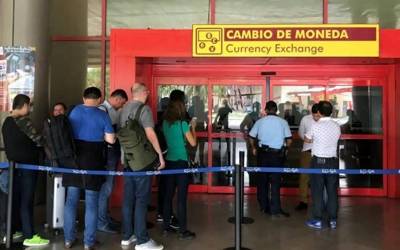How much money should I bring to Cuba?
This is not easy to answer. How much money should I bring to Cuba? If on a tour with the club my standard reply is $50 a day and that you have a credit card as back-up. You can use the credit card at a CADECA (bank) to get cash. You will be charged in USD at the exchange rate of the day. This will not be a great rate so keep to a minimum. Before leaving your home country inform your credit card company that you will be in Cuba, this will let them know the transaction is legitimate. It is very important to make sure your card is not from an American bank. A lot of Canadian Credit Union Credit Cards are connected to American banking systems and will not work here in Cuba.
The CADECA in Cuba can also give you a cash advance on your credit card (credit cards accepted in Cuba). They usually charge a one-off transaction fee, you will then need to speak to your credit card company to see what interest charges they will apply on top of the transaction fee. One way to avoid accumulating interest charges is to put money onto your credit card, this way you can use it as a debit card.
That being said, ATMs exist but do not expect them in every corner, most of the time they are really difficult to find in a pinch. When roaming Cuba cash is what you will need in your pocket, so plan accordingly before you leave your house or Hotel.


Currencies in Cuba
Cuba had two currencies. The Cuban peso (CUP), commonly called “moneda nacional” and there was also the Cuban Convertible Peso (CUC). in January 2021, Cuba eliminated the CUC and left the CUP as the only official Cuban currency. Therefore, as a traveler, you will use the CUP. So focus your efforts on getting CUP from the beginning instead, and try to get used to the CADECA (currency exchange houses) rates.
To avoid this surcharge we recommend changing your US Dollars to euros (Best), Canadian dollars or British pounds sterling. Also take into account Cuba’s currency is closed, so you can’t get it before you arrive, and you can’t take it with you when you leave.


Exchange rates
The exchange rates at the CADECA and at the bank are set daily by the Cuban government, there is very little difference between the exchange rates found at either the CADECA or the bank in Cuba. Therefore, there is no real point in spending the day shopping around for the best rate. I tend to use the CADECA more, as for me it is fast and fairly pain free and more conveniently located. However, make sure you get a receipt for each transaction, take your time before leaving the teller and check that the teller has given you the correct amount back, as they count the money really fast in front of you and I have been short changed in the past!
Gratuities
It is common to tip for service while travelling. From bell boy to barman, they make a living by serving you well. On our tour staff; driver, mechanic and ride director are all part of the tourist trade and you will be well taken care of by this team. It is not mandatory that any tourist tip any worker but people are always asking for guide lines and this is what I do myself while travelling. If my room is clean and tidy with towels etc. In place, Then I will leave $1 on the bed in the morning, this is travel etiquette shall we say. As for the ride staff a gratuity of around “$80USD to $100 USD is common for a two week ride or” $4USD to $6USD /day. We prefer you tip directly and individually to each employee.
Please do not tip in US coins or damaged notes, these can not be used in Cuba.